Tips for Arranging Succulents in Containers and Landscapes
Succulents are so beautiful in their own right, so it really doesn't take much to create a great arrangement for them. These techniques will help your arrangements really stand out!
Succulents and Sunshine is reader supported. We may earn a commission, if you purchase through links on our site, such as Mountain Crest Gardens, Amazon, or Etsy. We only promote products we use and trust.
Over the past few years I've created a lot of succulent arrangements for myself, for my ebooks, for the Idiot's Guide, and for my friends and family. I've also been privileged to work with some incredible succulent designers, and photograph their arrangements.
Every one of these designers has his or her own style and techniques–but it seems every arrangement is a work of art!

Throughout this article, you'll find links to purchase the succulents I mention in each of the design sections. I know it can be tricky to find colorful succulents locally, so these links can help you track down the plants you're looking for.
Consider Colors
One of my favorite things about succulents is that they come in virtually every color of the rainbow! This makes it a lot of fun to arrange succulents based on common colors and patterns. Since my background is in art, I'm always drawn to arrangements that really show off color schemes.
Some succulents are monochromatic–they have just one main color (usually green), but may have a variety of shades of that color.
When creating a monochromatic arrangement, it's great to use different shapes and textures to add more interest. Click here to see some succulents that would make an interesting monochromatic arrangement.
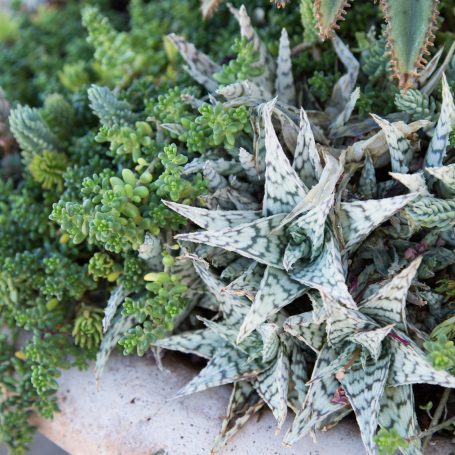
For succulents of a few different colors, you can look for groupings with analogous colors–shades that are next to each other on a color wheel. For example, you could use green, blue and purple or orange, yellow and green.
I tend to create arrangements focused on greens, blues and purples–but brighter arrangements with reds, oranges and yellows can be really eye-catching!
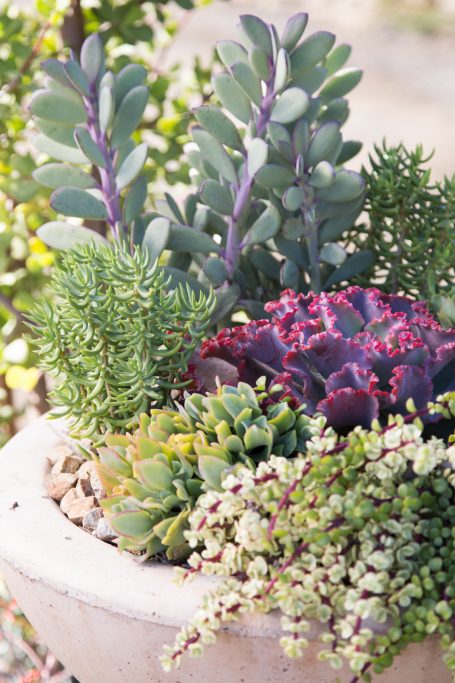
My favorite color schemes are based on complementary colors–shades that are opposite each other on the color wheel, like red and green, blue and orange, yellow and purple.
Blue and orange just happens to be my favorite color combination of succulents–probably because plants in blue or orange are very rare and unusual, and the colors are so intense. But this red and green arrangement is super vibrant and exciting, too!
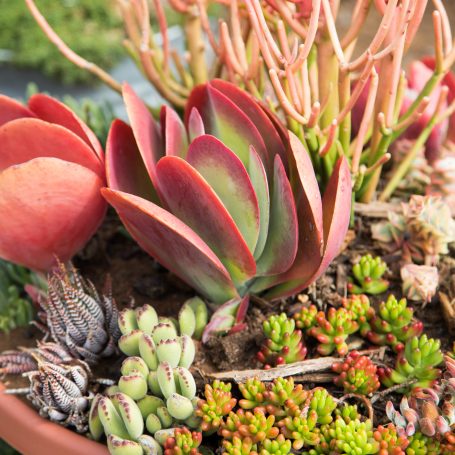
You can see more examples of these tips in the video below:
Thriller, Filler, Spiller
What's the deal with this little rhyme? It's actually a “formula” that's commonly used in the world of container arrangements–and it's probably one of the most widely suggested guidelines for designing an arrangement.
It's so simple, and it results in great arrangements every time.
A “thriller” succulent is one that's large, tall, spikey, or dramatically different from the other succulents in the arrangement. It should stand out as the first thing people notice when they see the design.
“Filler” succulents, on the other hand, make up the bulk of the arrangement. “Filler” doesn't mean boring or dull, though! Choose “filler” succulents that complement your “thriller” while still providing some visual interest, whether it's their color or texture. You can even use multiple succulent varieties!
“Spiller” succulents hang over the edge of the pot. These are typically trailing succulents like “String of Pearls“, “String of Bananas” or “String of Hearts“. These can also be longer succulents like Sedum “Burrito” that will eventually trail as they grow more.
Whatever kinds of “spiller” you choose, just make sure they cover the edge of your pot in some way. It can make all the difference for the longevity of your arrangement!
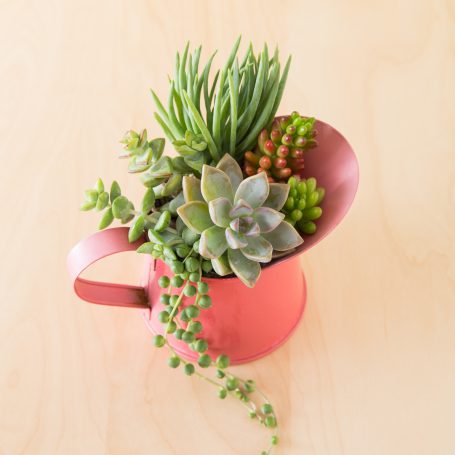
Check out the video below to see how I use these methods to design a large succulent grow box:
Consider Light Needs
As fun as it is to put together an exciting arrangement, it's also important to factor the kind of light your succulent needs in your design choices. While succulents growing indoors generally require as much light as possible, there's actually quite a bit of variation in the amount of sunlight each species needs.
For example, Sansevierias are very tolerant of low lighting and don't like full sun. Sedum nussbaumerianum on the other hand, needs full sun in order to maintain it's intense color and compact shape.
It's crucial to make sure your arrangement combines succulents with similar lighting needs.
A full list of the succulents that like full sun, or partial shade, or low light, could easily fill a whole book–or a website! However, you can identify the succulents you own and then look up their light needs on World of Succulents or San Marcos Growers.
A Google search for the succulent's name will also help you find out more about what they need in terms of light.
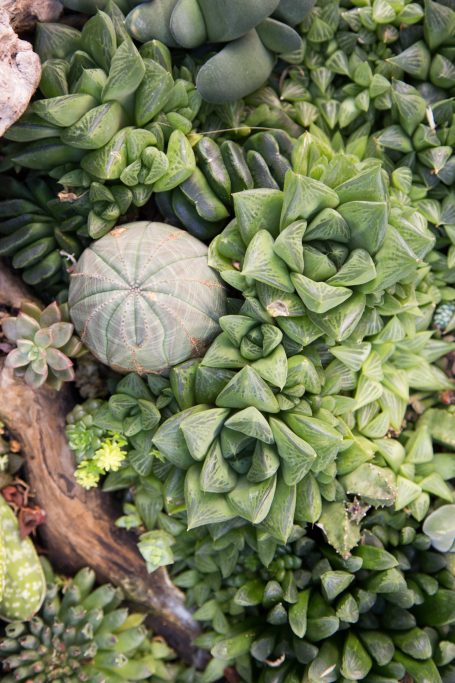
When you're planting succulents outdoors, it's important to make sure you choose species that can handle the amount of light they'll receive in your garden. Not all succulents will tolerate full sun, while others will wither away if they're shaded all day.
Combining succulents with similar lighting needs will ensure that your whole arrangement (or garden bed) stays looking great for years to come!
Leaf Thickness and Watering Needs
Just as your arrangement needs to combine plants with similar lighting needs, it's equally important to combine plants that need similar amounts of water.
The easiest way to tell a plant's water needs at a glance is by examining its leaf thickness. But if you're not sure, it's best to identify the succulents you're working with, and look up their specific watering needs on World of Succulents or San Marcos Growers, or just do a basic Google search for your succulent.
Whether you're following a specific technique, rule or tip, or just going wild and crazy making up your own rules, you'll find that succulents are a lot of fun to combine. There's really no “wrong way” to combine succulents, as long as they have similar light and watering needs, and you're using well-draining soil and proper watering techniques.
For even more tips and inspiration, just pick up a copy of my book, Idiot's Guides: Succulents.
And if you'd like to watch the video overview of these tips, you can watch below:
Speaking of stunning succulent arrangements… I wanted to show you an amazing succulent-filled table created by the couple behind Redeeming Eden. I had the opportunity to meet their wonderful family and was able to photograph several arrangements they had created.
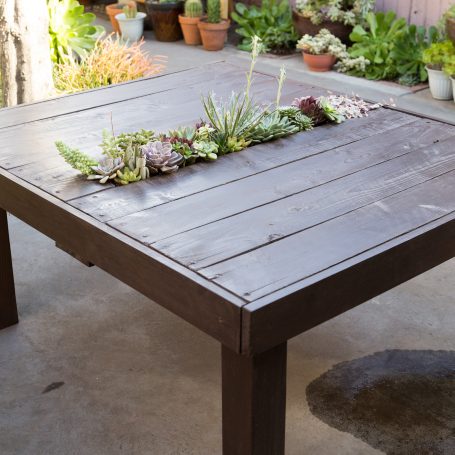
While I was in their garden I was immediately drawn to this table. Creating something like this has been on my to-do list for a while. After seeing theirs, I hope I can do as good a job. They built the table themselves and stained it with Olympic Maximum Waterproofing Sealant to prevent any water damage. I'm in love with how it looks!
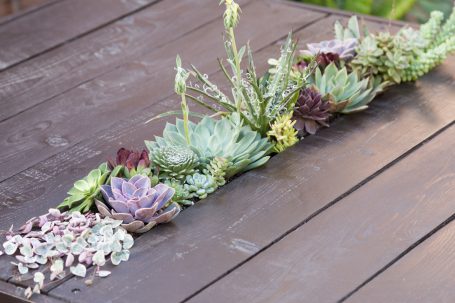
If you're looking to create a project like this, remember to add drainage holes to prevent your succulents from rotting. What a great way to make a statement though, right? The size of the table is perfect. Not too small, not too large. You could definitely add this to a seating area on your porch and it would be both useful and decorative.
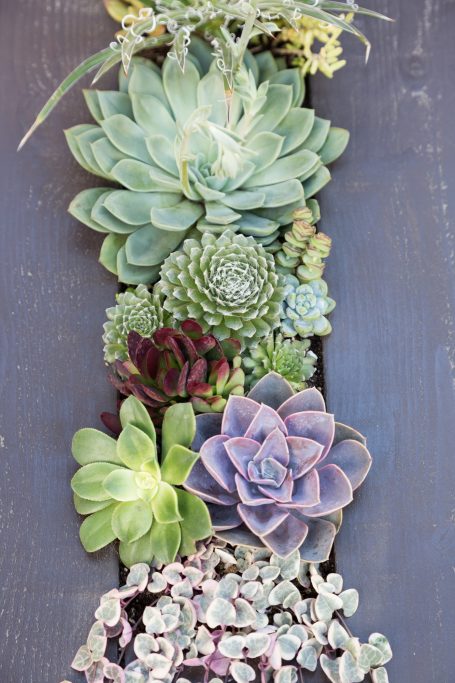
Are you feeling inspired to make something great with succulents?